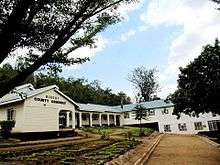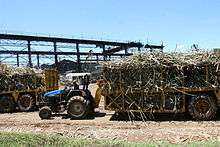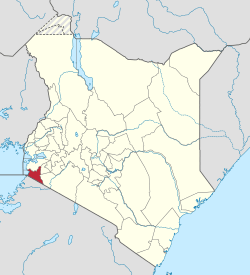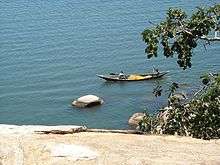Migori County



| Migori County | |
|---|---|
| County | |
|
Close to Awendo Town, Migori | |
 Location in Kenya | |
| Country |
|
| Formed | March 4, 2013 |
| Capital | Migori |
| Government | |
| • Governor | Zachary Obado |
| Area | |
| • Total | 2,586.4 km2 (998.6 sq mi) |
| Population (2009) | |
| • Total | 917,170 [1] |
| Time zone | EAT (UTC+3) |
| Website | migori.go.ke |
Migori County is a county in the former Nyanza Province of southwestern Kenya. Migori County is located in Western Kenya and borders Homa Bay to the North, Kisii to the North East, Narok to the East and South East, Tanzania to the South and South West and Lake Victoria to the West.The capital is Migori town which is also its largest town. The county has a population of 917,170. Migori County is perhaps the most diverse in Nyanza after Kisumu. The inhabitants include Suba-Luos, Luos, Kuria, Abagusii, Luhya, Somalis, a small pockets of Indians, Arabs, and Nubians. Migori town serves as in important link between Kenya and Tanzania and the second most viable commercial center in Luo-Nyanza after Kisumu. Other major towns in Migori county include Kehanncha and Isebania in Kuria District.
With the nationwide creation of new districts in 2007, Migori was split into Rongo (North) and Migori (South) districts. The headquarters of Migori County remain in Migori, and those of Rongo District moved to Rongo town. The split occurs between Suba and Uriri Division.
The Population density is 353 PER SQ. km and 43% of the population live below the poverty line. Age Distribution was 0–14 years 49%, 15–64 years 48% and over 65 years 3%.
Location
Migori Town (-1.0634,34.4731) is 368 kilometers from Nairobi. Migori town is bordered by hills.

Water bodies in the county include the Kuja and Migori rivers, and Lake Victoria)
Economy
The main economic activities include agriculture, fishing, manufacturing and mining. There is some small scale gold mining carried out in the country. The county also sees some limited commercial activity, mainly small and micro-enterprises in the Jua Kali sector. These include auto mechanics, furniture works, tailoring, welding, trade and agriculture.
Agricultural activity is carried out in areas such as Ngege, Oyani and Anjego. There is a National cereals board depot in Migori Town.
Flora and fauna
Some common trees and shrubs include Bondo (Euphorbia candelabrum), Ochwoga (Carissa edulis), Mukinduri (Croton megalocarpus), Ngow, Bong'u (Ficus spp), Onera (Terminalia brownii), Toona ciliata, Ochond rateng'/Musaja (Sapium spp), Oncoba spinosa ,Terminalia catappa, Cypress.
The birdlife here is varied with many records of blue flycatcher, blue-spotted wood dove, harrier hawk, bat hawk, baglafecht weaver, tawny eagle, purple grenadier, sunbird, yellow-billed stork, hadada ibis, African citril, cape turtle dove, paradise flycatcher, yellow white eye, white-browed robin chat, black-headed gonolek, black kite among others.
Education
Only 15% of Migori County residents have secondary level of education or above. Rongo constituency has the highest share of residents with a secondary level of education or above at 19%. This is 7 percentage points above Kuria East constituency, which has the lowest share.
Rongo constituency is 4 percentage points above the county average. Suna Central ward has the highest share of residents with a secondary level of education or above at 31%.This is five times Wasimbete ward, which has the lowest share of residents with a secondary level of education or above. Suna Central ward is 16 percentage points above the county average.
A total of 65% of Migori County residents have a primary level of education only. Uriri constituency has the highest share of residents with a primary level of education only at 68%. This is 5 percentage points above Kuria West constituency, which has the lowest share of residents with a primary level of education only. Uriri constituency is 3 percentage points above the county average. West Kanyamkago ward has the highest share of residents with a primary level of education only at 71%. This is 19 percentage points above Isibania ward, which has the lowest share of residents with primary only. West Kanyamkago ward is 6 percentage points above the county average.
Some 20% of Migori County residents have no formal education. Kuria East constituency has the highest share of residents with no formal education at 24%.This is 6 percentage points above Rongo constituency, which has the lowest share of residents with no formal education. Kuria East constituency is 4 percentage points above the county average. Ntimaru East ward has the highest percentage of residents with no formal education at 31%. This is twice Central Kamagambo ward, which has the lowest percentage of residents with no formal education. Ntimaru ward is 11 percentage points above the county average.
Employment
In Migori County, 9% of the residents with no formal education, 9% of those with a primary education and 22% of those with a secondary level of education or above are working for pay.
Roads
The total length of all classified roads in the county is 910 km with bitumen surface covering 72 km, gravel Surface 324 km and earth surface 514 km.
Energy
Only 1% of residents in Migori County use liquefied petroleum gas (LPG), and 2% use paraffin. 80% use firewood and 17% use charcoal. Firewood is the most common cooking fuel by gender with 85% of female headed households and 77% of male headed households using it.
Uriri constituency has the highest level of firewood use in Migori County at 93%.This is 23 percentage points above Suna West constituency, which has the lowest share at 70%. Uriri constituency is about percentage points above the county average. West Kanyamkago ward has the highest level of firewood use in Migori County at 98%.This is five times Isibania ward, which has the lowest share. West Kanyamkago ward is 18 percentage points above the county average.
Suna West constituency has the highest level of charcoal use in Migori County at 26%.This is 20 percentage points above Uriri constituency, which has the lowest share. Suna West constituency is 9 percentage points above the county average. Isibania ward has the highest level of charcoal use in Migori County at 71%.This is 69 percentage points more than Kaler ward, which has the lowest share. Isibania ward is 54 percentage points above the county average. Only 5% of residents in Migori County use electricity as their main source of lighting. A further 26% use lanterns, and 66% use tin lamps. 1% use fuel wood. Electricity use is mostly common in male headed households at 6% as compared with female headed households at 4%.
Awendo constituency has the highest level of electricity use at 11%.That is 11 percentage points above Kuria East constituency, which has the lowest level of electricity use. Awendo constituency is 6 percentage points above the county average. Isibania ward has the highest level of electricity use at 26%.That is 26 percentage points above Ntimaru East ward, which has no level of electricity use. Isibania ward is 21 percentage points above the county average
Health
Migori County has 4 District Hospitals and 5 Sub-District Hospitals.
The most prevalent diseases in the county are Malaria, HIV/AIDs, Diarrhea, URTI (Urinary Tract Infections)
Religion
The vast majority of Migori- Kenyans are Christians, and the Anglican and Roman Catholic Churches are the most established Christian denominations. Other well established African religions and denominations include the African Inland Church (AIC), Seventh Day Adventists (SDA), and the Presbyterian Church of East Africa (PCEA).
In addition, there are a number of Evangelical churches and Independent African Christian churches.
Islam is another major religion in Migori. Followers include both Sunni and Shi'ite Muslims. The largest number of Muslims in Migori are found in Migori town centre and the neighboring regions.
Many of the traditional African religions are no longer widely practiced. Some of the denominations considered as indigenous religions combine aspects of Christianity with traditional religious beliefs. One of these denominations is Legion Maria and Roho Israel, found mostly in rural areas
The few Migorians who adhere Hinduism and Sikhism are mostly Indians. They reside mostly in Migori Town.
Subdivisions
| Local authorities (councils) | ||||
| Authority | Type | Population* | Urban pop.* | |
|---|---|---|---|---|
| Migori | Municipality | 46,576 | 31,644 | |
| Awendo | Town | 93,387 | 13,760 | |
| Rongo | Town | 64,528 | 6,175 | |
| Migori County | County | 310,406 | 4,331 | |
| Total | - | 514,897 | 55,910 | |
| * 1999 census. Source: | ||||
The county has four constituencies:[2]
Villages and settlements
See also
External links
References
Coordinates: 0°40′S 34°50′E / 0.667°S 34.833°E
